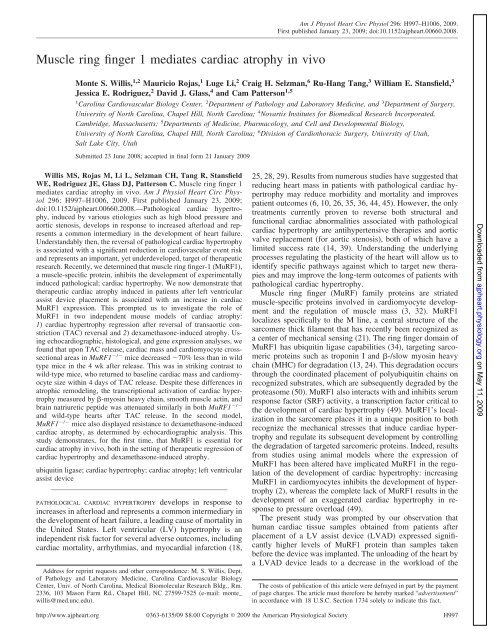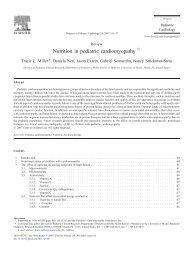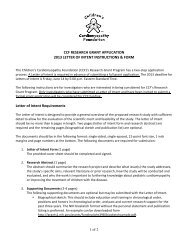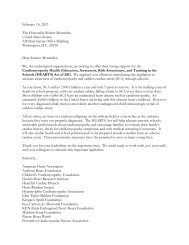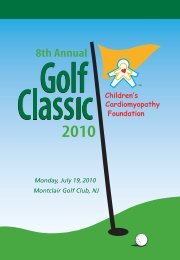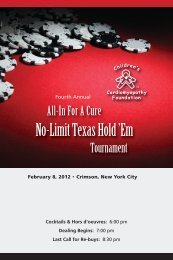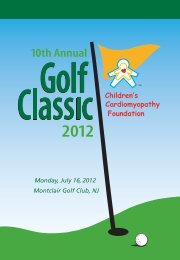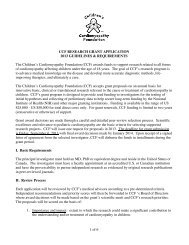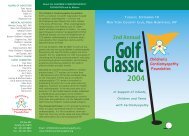William E. Stansfield, Jessica E. Rodriguez, David J. Glass and Cam ...
William E. Stansfield, Jessica E. Rodriguez, David J. Glass and Cam ...
William E. Stansfield, Jessica E. Rodriguez, David J. Glass and Cam ...
- No tags were found...
You also want an ePaper? Increase the reach of your titles
YUMPU automatically turns print PDFs into web optimized ePapers that Google loves.
Am J Physiol Heart Circ Physiol 296: H997–H1006, 2009.First published January 23, 2009; doi:10.1152/ajpheart.00660.2008.Muscle ring finger 1 mediates cardiac atrophy in vivoMonte S. Willis, 1,2 Mauricio Rojas, 1 Luge Li, 2 Craig H. Selzman, 6 Ru-Hang Tang, 3 <strong>William</strong> E. <strong>Stansfield</strong>, 3<strong>Jessica</strong> E. <strong>Rodriguez</strong>, 2 <strong>David</strong> J. <strong>Glass</strong>, 4 <strong>and</strong> <strong>Cam</strong> Patterson 1,51Carolina Cardiovascular Biology Center, 2 Department of Pathology <strong>and</strong> Laboratory Medicine, <strong>and</strong> 3 Department of Surgery,University of North Carolina, Chapel Hill, North Carolina; 4 Novartis Institutes for Biomedical Research Incorporated,<strong>Cam</strong>bridge, Massachusetts; 5 Departments of Medicine, Pharmacology, <strong>and</strong> Cell <strong>and</strong> Developmental Biology,University of North Carolina, Chapel Hill, North Carolina; 6 Division of Cardiothoracic Surgery, University of Utah,Salt Lake City, UtahSubmitted 23 June 2008; accepted in final form 21 January 2009Willis MS, Rojas M, Li L, Selzman CH, Tang R, <strong>Stansfield</strong>WE, <strong>Rodriguez</strong> JE, <strong>Glass</strong> DJ, Patterson C. Muscle ring finger 1mediates cardiac atrophy in vivo. Am J Physiol Heart Circ Physiol296: H997–H1006, 2009. First published January 23, 2009;doi:10.1152/ajpheart.00660.2008.—Pathological cardiac hypertrophy,induced by various etiologies such as high blood pressure <strong>and</strong>aortic stenosis, develops in response to increased afterload <strong>and</strong> representsa common intermediary in the development of heart failure.Underst<strong>and</strong>ably then, the reversal of pathological cardiac hypertrophyis associated with a significant reduction in cardiovascular event risk<strong>and</strong> represents an important, yet underdeveloped, target of therapeuticresearch. Recently, we determined that muscle ring finger-1 (MuRF1),a muscle-specific protein, inhibits the development of experimentallyinduced pathological; cardiac hypertrophy. We now demonstrate thattherapeutic cardiac atrophy induced in patients after left ventricularassist device placement is associated with an increase in cardiacMuRF1 expression. This prompted us to investigate the role ofMuRF1 in two independent mouse models of cardiac atrophy:1) cardiac hypertrophy regression after reversal of transaortic constriction(TAC) reversal <strong>and</strong> 2) dexamethasone-induced atrophy. Usingechocardiographic, histological, <strong>and</strong> gene expression analyses, wefound that upon TAC release, cardiac mass <strong>and</strong> cardiomyocyte crosssectionalareas in MuRF1 / mice decreased 70% less than in wildtype mice in the 4 wk after release. This was in striking contrast towild-type mice, who returned to baseline cardiac mass <strong>and</strong> cardiomyocytesize within 4 days of TAC release. Despite these differences inatrophic remodeling, the transcriptional activation of cardiac hypertrophymeasured by -myosin heavy chain, smooth muscle actin, <strong>and</strong>brain natriuretic peptide was attenuated similarly in both MuRF1 /<strong>and</strong> wild-type hearts after TAC release. In the second model,MuRF1 / mice also displayed resistance to dexamethasone-inducedcardiac atrophy, as determined by echocardiographic analysis. Thisstudy demonstrates, for the first time, that MuRF1 is essential forcardiac atrophy in vivo, both in the setting of therapeutic regression ofcardiac hypertrophy <strong>and</strong> dexamethasone-induced atrophy.ubiquitin ligase; cardiac hypertrophy; cardiac atrophy; left ventricularassist devicePATHOLOGICAL CARDIAC HYPERTROPHY develops in response toincreases in afterload <strong>and</strong> represents a common intermediary inthe development of heart failure, a leading cause of mortality inthe United States. Left ventricular (LV) hypertrophy is anindependent risk factor for several adverse outcomes, includingcardiac mortality, arrhythmias, <strong>and</strong> myocardial infarction (18,Address for reprint requests <strong>and</strong> other correspondence: M. S. Willis, Dept.of Pathology <strong>and</strong> Laboratory Medicine, Carolina Cardiovascular BiologyCenter, Univ. of North Carolina, Medical Biomolecular Research Bldg., Rm.2336, 103 Mason Farm Rd., Chapel Hill, NC 27599-7525 (e-mail: monte_willis@med.unc.edu).25, 28, 29). Results from numerous studies have suggested thatreducing heart mass in patients with pathological cardiac hypertrophymay reduce morbidity <strong>and</strong> mortality <strong>and</strong> improvespatient outcomes (6, 10, 26, 35, 36, 44, 45). However, the onlytreatments currently proven to reverse both structural <strong>and</strong>functional cardiac abnormalities associated with pathologicalcardiac hypertrophy are antihypertensive therapies <strong>and</strong> aorticvalve replacement (for aortic stenosis), both of which have alimited success rate (14, 39). Underst<strong>and</strong>ing the underlyingprocesses regulating the plasticity of the heart will allow us toidentify specific pathways against which to target new therapies<strong>and</strong> may improve the long-term outcomes of patients withpathological cardiac hypertrophy.Muscle ring finger (MuRF) family proteins are striatedmuscle-specific proteins involved in cardiomyocyte development<strong>and</strong> the regulation of muscle mass (3, 32). MuRF1localizes specifically to the M line, a central structure of thesarcomere thick filament that has recently been recognized asa center of mechanical sensing (21). The ring finger domain ofMuRF1 has ubiquitin ligase capabilities (34), targeting sarcomericproteins such as troponin I <strong>and</strong> -/slow myosin heavychain (MHC) for degradation (13, 24). This degradation occursthrough the coordinated placement of polyubiquitin chains onrecognized substrates, which are subsequently degraded by theproteasome (50). MuRF1 also interacts with <strong>and</strong> inhibits serumresponse factor (SRF) activity, a transcription factor critical tothe development of cardiac hypertrophy (49). MuRF1’s localizationin the sarcomere places it in a unique position to bothrecognize the mechanical stresses that induce cardiac hypertrophy<strong>and</strong> regulate its subsequent development by controllingthe degradation of targeted sarcomeric proteins. Indeed, resultsfrom studies using animal models where the expression ofMuRF1 has been altered have implicated MuRF1 in the regulationof the development of cardiac hypertrophy: increasingMuRF1 in cardiomyocytes inhibits the development of hypertrophy(2), whereas the complete lack of MuRF1 results in thedevelopment of an exaggerated cardiac hypertrophy in responseto pressure overload (49).The present study was prompted by our observation thathuman cardiac tissue samples obtained from patients afterplacement of a LV assist device (LVAD) expressed significantlyhigher levels of MuRF1 protein than samples takenbefore the device was implanted. The unloading of the heart bya LVAD device leads to a decrease in the workload of theThe costs of publication of this article were defrayed in part by the paymentof page charges. The article must therefore be hereby marked “advertisement”in accordance with 18 U.S.C. Section 1734 solely to indicate this fact.Downloaded from ajpheart.physiology.org on May 11, 2009http://www.ajpheart.org0363-6135/09 $8.00 Copyright © 2009 the American Physiological SocietyH997


